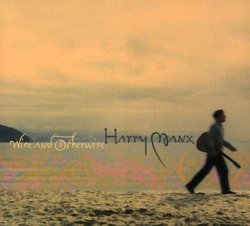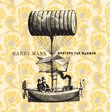| All Artists: Harry Manx Title: Wise & Otherwise - Reissue Members Wishing: 2 Total Copies: 0 Label: Dog My Cat Records Release Date: 5/8/2007 Genres: Blues, International Music, Pop Styles: Slide Guitar, Reggae Number of Discs: 1 SwapaCD Credits: 1 UPC: 623667212663 |
Search - Harry Manx :: Wise & Otherwise - Reissue
 | Harry Manx Wise & Otherwise - Reissue Genres: Blues, International Music, Pop
Canadian bluesman Harry Manx makes what sounds like a recipe for disaster--acoustic covers of "The Thrill Is Gone" and "Foxy Lady" featuring the veena, a South Indian stringed instrument somewhat similar to the banjo--work... more » |
Larger Image |
CD DetailsSynopsis
Amazon.com Canadian bluesman Harry Manx makes what sounds like a recipe for disaster--acoustic covers of "The Thrill Is Gone" and "Foxy Lady" featuring the veena, a South Indian stringed instrument somewhat similar to the banjo--work surprisingly well. Manx comes by the Indian influences in his music honestly. He spent 25 years in India before relocating to Canada, where NorthernBlues (home of the equally accomplished Otis Taylor) has presented his second album, a follow-up to 2001's Dog My Cat. Wise and Otherwise continues the unusual but highly successful mix of traditional acoustic blues and Indian music pioneered on Manx's first album, though the inevitable comparisons to Kelly Joe Phelps are still apt. It's a little different from what you'd normally expect out of an acoustic bluesman, perhaps, but certainly none the worse for that. --Genevieve Williams Similar CDs
|
CD ReviewsWise and Wiser to buy this Arthur Shuey | Wilmington, NC USA | 01/30/2006 (5 out of 5 stars) "Wise and Otherwise Harry Manx Northern Blues NBM0008 An instrument prominently featured on this record is the mohan veena, used in the whole Western world by only Harry Manx and the late George Harrison. Vishwa Mohan Bhatt developed and named this hybrid slide guitar, which is a highly modified archtop guitar, played lap-style. It has 19 strings: three melody strings and four three drone strings coming out of the peg heads, and 12 sympathetic strong to tuners mounted to a piece of wood added to the side of the neck. The melody strings are on what we would consider the treble side of the neck, and the drone strings are on the bass side. The drone strings are lower in height than the melody strings to allow for unrestricted playing of the melody strings. The sympathetic strings run underneath the melody and drone strings to yet another level in the bridge. The instrument has a carved spruced top, mahogany back and sides, a mahogany neck, and a flat, fretless, rosewood fingerboard. It is under tremendous tension; the total strings pull to be in excess of 500 pounds, which creates strong tones more intensely abetted by the sympathetic strings with each note played. It is also a very loud instrument made to cut through with low amplification, like a banjo or resonator guitar. Now you're ready for next Thursday's pop quiz on mohan veena, but that doesn't mean you're ready for Harry Manx. I think that preparation takes decades, and the right decades at that. In brief, I think that Harry Manx was born at approximately the same time rock was born and has matured with it, and that his music is for listeners who have done likewise. The familiar covers from Wise and Otherwise, "Foxy Lady(Jimi Hendrix)," "The Thrill Is Gone(B.B. King)" and "Crazy Love(Van Morrison)" are all from the cusp of our popular music, right between the British Invasion and FM radio rock. His originals come from that same time and place, an environment in which musicians suddenly found themselves with more than three minutes per song in which to communicate with large audiences and responded with a commitment to more sophisticated messages. Without Neil Young's periodic reliance on electric amplification, Manx shares his fascination for strong visual images and ability to spin dramatic stories from them. Among the seven and a half Manx originals on this album are "Tethered Dogs," "Roses Given" and "Coat of Mail," all three rooted as strongly in sight as in sound. Harmonica, slide guitar and banjo complete Wise and Otherwise instrumentation, all played by Manx. Vocal duties hereon are all his, too. Production values aren't the highest. It sounds as if the microphones were better than their placement in the studio, and another layer of mixing might have gotten rid of that feedback. This album is good in random rotation on a CD changer with vintage Taj Mahal, Van Morrison, Bonnie Raitt and George Harrison. It is in a class with those recordings. I am very, very glad to have it." Tremendously talented. P.J. Le Faucheur | Canada (ex- U.K. resident) | 10/04/2006 (5 out of 5 stars) "I just saw an interview with Harry Manx on a Canadian Blues programme called "Talkin' Blues". I have to say i was totally knocked out by his very sincere approach, his gentle manner and calm and happy countenance.
He's got to be one of the nicest musicians on the planet. He's also tremendously talented having studied the Mohan Vina under the guidance of V.M. Bhatt for 5 years in India. This is NO easy task. His sound reminds me of Kelly Joe Phelps but perhaps his style is a tad more varied. If you buy any CD of Harrys i don't think you'll be disappointed at all." |

 Track Listings (12) - Disc #1
Track Listings (12) - Disc #1


